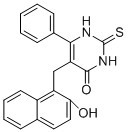Cambinol
This product is for research use only, not for human use. We do not sell to patients.

For small sizes, please check our retail website as below: www.invivochem.com
| Size | Price | Stock |
|---|---|---|
| 250mg | $750 | Check With Us |
| 500mg | $1350 | Check With Us |
| 1g | $2025 | Check With Us |
Cat #: V3226 CAS #: 14513-15-6 Purity ≥ 98%
Description: Cambinol (formerly NSC-112546) is a potent SIRT (silent information regulator enzymes) inhibitor with IC50 values of 56 and 59 μM for SIRT1 and SIRT2, respectively.
Top Publications Citing Invivochem Products
Publications Citing InvivoChem Products
Product Promise

- Physicochemical and Storage Information
- Protocol
- Related Biological Data
- Stock Solution Preparation
- Quality Control Documentation
| Molecular Weight (MW) | 360.43 |
|---|---|
| Molecular Formula | C21H16N2O2S |
| CAS No. | 14513-15-6 |
| Storage | -20℃ for 3 years in powder formr |
| -80℃ for 2 years in solvent | |
| Solubility In Vitro | DMSO: >150 mg/mLr |
| Water:r | |
| Ethanol: | |
| SMILES Code | O=C(C(CC1=C2C=CC=CC2=CC=C1O)=C(C3=CC=CC=C3)N4)NC4=S |
| Synonyms | SIRT 1/2 inhibitor IV; SIRT1 Inhibitor II; SIRT2 Inhibitor VI; NSC112546; NSC-112546; NSC 112546 |
| Protocol | In Vitro | Cambinol inhibits NAD-dependent deacetylase activity of human SIRT1 and SIRT2. Inhibition of SIRT1 activity with cambinol during genotoxic stress leads to hyperacetylation of key stress response proteins and promotes cell cycle arrest. Treatment of BCL6-expressing Burkitt lymphoma cells with cambinol as a single agent induces apoptosis, which is accompanied by hyperacetylation of BCL6 and p53. Cambinol has only weak inhibitory activity against SIRT5 (42% inhibition at 300 μM) and no activity against SIRT3. |
|---|---|---|
| In Vivo | Cambinol is well tolerated in mice (100 mg/kg) and inhibits growth of Burkitt lymphoma xenografts. No significant weight loss occurs in cambinol-treated animals relative to controls. Inhibitors of NAD-dependent deacetylases may constitute novel anticancer agents. |
These protocols are for reference only. InvivoChem does not
independently validate these methods.
| Solvent volume to be added | Mass (the weight of a compound) | |||
|---|---|---|---|---|
| Mother liquor concentration | 1mg | 5mg | 10mg | 20mg |
| 1mM | 2.7745 mL | 13.8723 mL | 27.7446 mL | 55.4893 mL |
| 5mM | 0.5549 mL | 2.7745 mL | 5.5489 mL | 11.0979 mL |
| 10mM | 0.2774 mL | 1.3872 mL | 2.7745 mL | 5.5489 mL |
| 20mM | 0.1387 mL | 0.6936 mL | 1.3872 mL | 2.7745 mL |
The molarity calculator equation
Mass(g) = Concentration(mol/L) × Volume(L) × Molecular Weight(g/mol)
Mass
=
Concentration
×
Volume
×
Molecular Weight*
The dilution calculator equation
Concentration(start)
×
Volume(start)
=
Concentration(final)
×
Volume(final)
This equation is commonly abbreviated as: C1 V1 = C2 V2
Concentration(start)
C1
×
Volume(start)
V1
=
Concentration(final)
C2
×
Volume(final)
V2
Step One: Enter information below
Dosage mg/kg
Average weight of animals g
Dosing volume per animal µL
Number of animals
Step Two: Enter the in vivo formulation
%DMSO
+
%
+
%Tween 80
+
%ddH2O
Calculation Results:
Working concentration:
mg/ml;
Method for preparing DMSO master liquid:
mg
drug pre-dissolved in
µL
DMSO(Master liquid concentration
mg/mL)
,Please contact us first if the concentration exceeds the DMSO solubility of the batch of drug.
Method for preparing in vivo formulation:
Take
µL
DMSO master liquid, next add
µL
PEG300, mix and clarify, next add
µL
Tween 80,mix and clarify, next add
µL
ddH2O,mix and clarify.
Note:
- (1) Please be sure that the solution is clear before the addition of next solvent. Dissolution methods like vortex, ultrasound or warming and heat may be used to aid dissolving.
- (2) Be sure to add the solvent(s) in order.




































